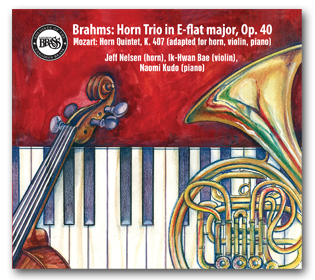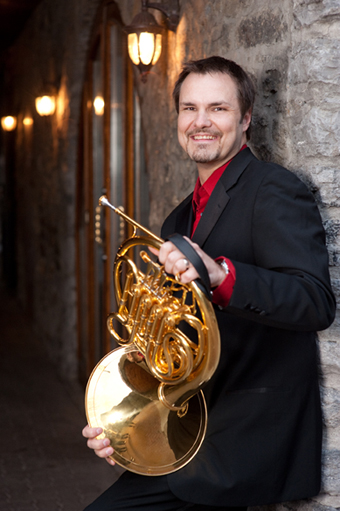
Brahms: Horn Trio in E-flat major, Op. 40
Mozart: Horn Quintet, K. 407 (adapted for horn, violin & piano)
ODR 7384
Opening Day Records
Release date: September 14, 2010
"The new Brahms Horn Trio by the wonderful hornist Jeff Nelsen of the Canadian Brass is a "MUST HEAR" performance which, I am sure, will be received with high musical and technical praise of his artistry. Enjoy!"
- Dale Clevenger, principal horn, Chicago Symphony Orchestra
Jeff Nelsen is joined by veteran violinist Ik-Hwan Bae and new piano sensation Naomi Kudo in an intimate reading of one of the most revered and best-loved chamber works in the classical canon - the Brahms Horn Trio, Op. 40.
Along with the Brahms Horn Trio is the premier recording of the Mozart Horn Quintet, K. 407 adapted for horn, violin and piano by noted arranger Tony Rickard. The work includes a unique cadenza in the last movement – Rondo: Allegro – written by the soloist, Jeff Nelsen. Here he offers his thoughts on the creative process behind the music.
 “Performing music and composing music are two completely separate arts. After attempting to write the Mozart cadenza for this recording, I am a performer, and as I suspected, composers deserve immense respect.
“Performing music and composing music are two completely separate arts. After attempting to write the Mozart cadenza for this recording, I am a performer, and as I suspected, composers deserve immense respect.
Cadenzas are meant to be moments for musicians to look back on what has been created thus far in the piece. A quote or two from other famous musical works are often shared between artists and audience as well, with hopes of inspiring an appreciative nod or a knowing grin. Performers will show some extra virtuosity that might be lurking both under their fingers and in the mysterious corners of their minds.
In 2004, I wrote and recorded a cadenza for this Rondo on the Juno nominated Canadian Brass recording Magic Horn. I am quite fond of that recording, so I begin this 2010 cadenza with the same opening notes that are straight out of the beginning of the Rondo. The remembrance of 2004 quickly leaps back to 1915 on the high notes, with a quote from my favorite piece by Richard Strauss, his An Alpine Symphony (The Epilogue). The Alpine's epilogue flows well into the overture to Mozart's opera The Magic Flute.
Since I quoted the Mozart bassoon concerto in 2004 for my bassoonist sister Suzanne, I wanted to quote Mozart's flute opera for my flautist sister Lisa here. The slow moment that follows is from the beautiful preceding Andante. This is my favorite part of the cadenza.
Now it is time for the big run to the end! We begin with a Mozart-style build that leads into what hornists call "lip trills", varying the notes Mozart used to begin the Rondo. The trills and runs sound like they will end the cadenza, but we go higher yet, and triumphantly finish with a fearless flash of "Der Hölle Rache kocht in meinem Herzen", Mozart's magical "Queen of the Night Aria".
Jeff Nelsen
July, 2010